Ever wondered why some goddesses send quakes down our spines? In the vast window of world mythologies, evil goddesses are fascinating figures that challenge our perceptions of divinity.
These powerful female deities, often associated with chaos, destruction, and the darker aspects of nature, have charmed imaginations for millennia.
Today, we’re diving deep into the realm of dark goddesses, exploring eight of the most notorious names that have left their mark on human culture and belief systems.
8 Most Notorious Evil Goddesses: The Dark Legends
When we talk about evil goddesses, it’s important to understand that the “evil” varies greatly across cultures and periods. What one society might view as evil, another might see as a necessary force of nature or a misunderstood deity.
These dark goddesses often represent aspects of life that humans find frightening or difficult to control, such as death, war, or the wild forces of nature.
Many of these evil deities have complex personalities and express both destructive and creative forces. They challenge our understanding of good and evil, reminding us that the divine feminine can be as fierce and terrifying as it is nurturing and protective.
As we discuss these eight notorious names, their stories are rich with symbolism and cultural significance, often reflecting the values and fears of the societies that worshipped them.
List of Famous Evil Gods
While our focus today is on evil goddesses, it’s worth noting that male deities also play significant roles in the pantheons of dark folklore.
Gods like Hades in Greek mythology, Set in Egyptian lore, or Loki in Norse tales often embody qualities that humans associate with evil or chaos.
Female deities often bring a unique perspective to these roles, blending aspects of creation and destruction in ways that challenge traditional gender norms.
Kali: The Fierce Destroyer
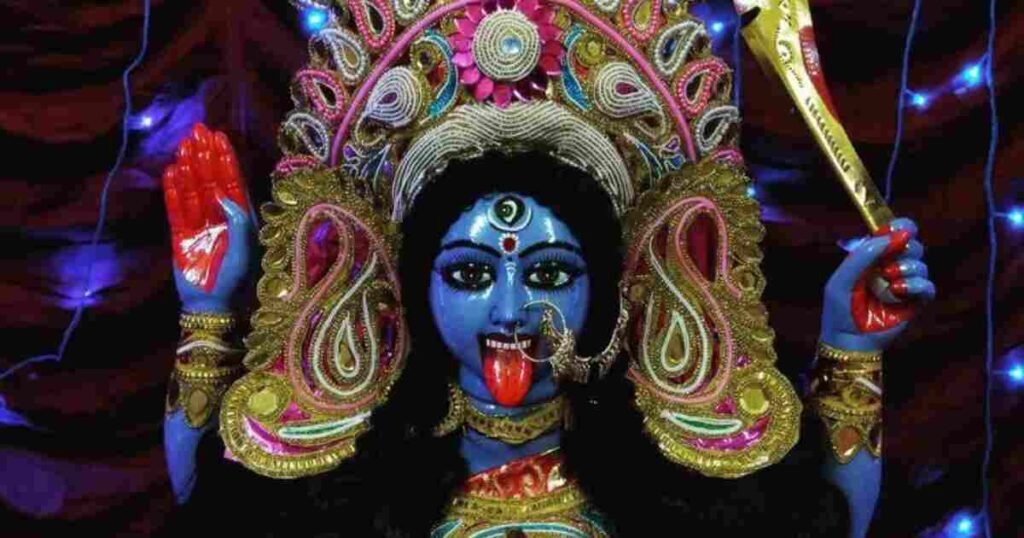
Kali, known as the Fierce Destroyer in Hindu mythology, is a powerful goddess often depicted with dark skin, a necklace of skulls, and a fearsome expression.
She symbolizes destruction, not as evil, but as a necessary force for transformation and renewal. Her fierce image represents the end of ego and ignorance, paving the way for spiritual growth.
Despite her fearsome appearance, Kali is revered as a protector by her followers. Her role in the cosmic cycle is essential, as she destroys only to allow for new beginnings.
To Hindus, she is a fierce warrior and a compassionate mother, fiercely guarding her devotees from harm.
Kali’s power is often misunderstood in Western culture, where she is sometimes seen as merely a symbol of death or chaos.
In Hinduism, she is honored as the ultimate force that helps people overcome inner darkness and achieve spiritual liberation. Her story teaches that destruction is part of life’s natural balance.
Kali’s Fearsome Appearance
Kali’s appearance is both striking and symbolic. She is often shown with dark blue or black skin, which represents the vastness of the cosmos. Her necklace of skulls and skirt of severed arms symbolize the cycles of life and death.
Her protruding tongue and fierce expression reflect her role as a destroyer of ignorance. This fearsome look emphasizes her power to clear away the old and make way for new beginnings.
| Criteria | Description |
| Name | Kali |
| Domain | Hindu goddess of destruction, time, and death |
| Consort | Often depicted as the consort of Shiva, the god of destruction and transformation |
| Symbols | Dark complexion, tongue sticking out, skulls, severed heads, bloodied weapons |
| Attributes | Destruction, death, time, transformation, empowerment, liberation |
Read Also: Fun Facts About Athens
Hecate: The Greek Evil Goddesses
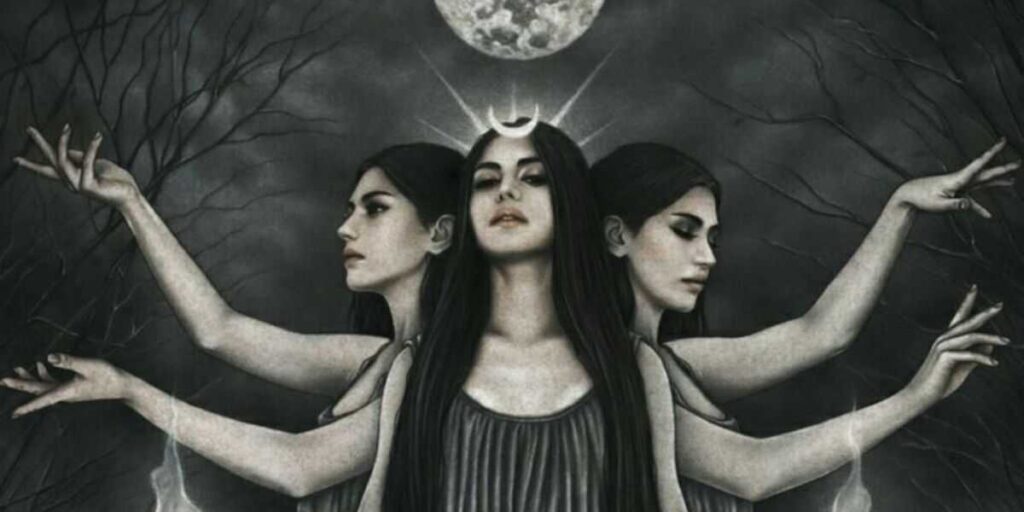
Hecate is a powerful figure in Greek mythology, known for her connection to magic and the underworld. Often seen as an evil goddess, she was feared and respected for her control over dark forces and spirits.
Her role was crucial in guiding souls through the mysterious realms beneath the earth. As the goddess of witchcraft, Hecate ruled over crossroads, where the paths of life and death met.
Her link to the underworld gave her the ability to move between worlds, making her a key player in many myths. Despite being feared, she also helped those seeking wisdom and protection.
While some viewed Hecate as an evil goddess, others saw her as a protector who wielded great power. Her dual nature made her both revered and dreaded in Greek mythology, symbolizing the fine line between light and dark.
Hecate’s Sacred Animals and Symbols
Hecate’s sacred animals were often associated with darkness and mystery. Dogs, especially black ones, were her primary companions, symbolizing loyalty and protection.
Other animals like owls and serpents also represented her deep connection to the unseen world. As for her symbols, torches and keys were the most important.
The torches lit her way through the underworld, while the keys symbolized her power to unlock the gates between worlds. These objects highlighted her role as a guide and protector in Greek mythology.
| Criteria | Description |
| Name | Hecate |
| Domain | Goddess of magic, witchcraft, crossroads, ghosts, and the night |
| Parentage | Daughter of Perses and Asteria, or sometimes seen as a Titaness or daughter of Zeus |
| Symbols | Torch, keys, dagger, dogs, crossroads, moon, and snakes |
| Attributes | Magic, witchcraft, protection, guidance, and wisdom |
Morrigan: Celtic Queen of Battle
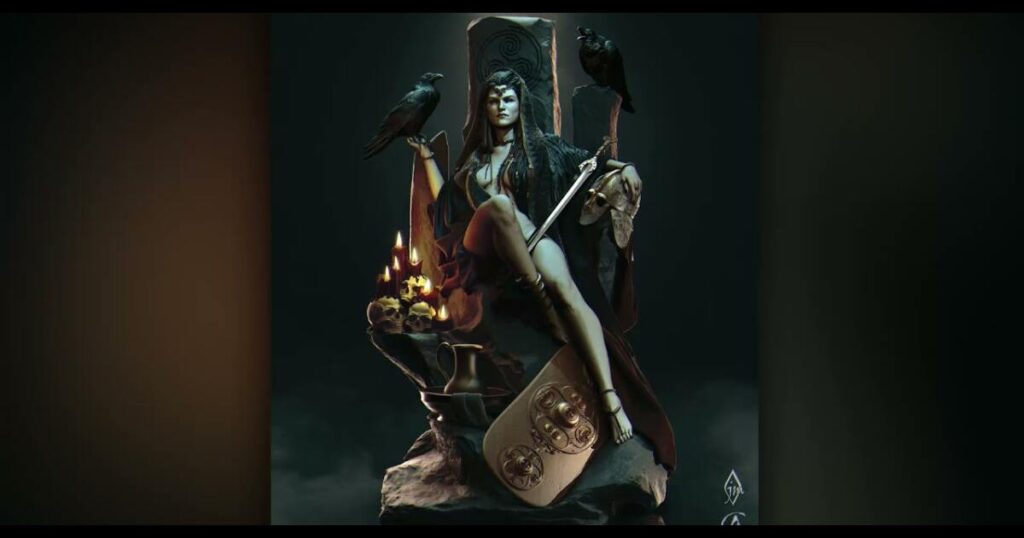
The Morrigan, often called the Celtic Queen of Battle, is a fascinating figure in Celtic mythology. She’s not your typical evil goddess, but rather a complex character who embodies both the terror and the glory of warfare.
Imagine a powerful woman who can transform into a crow, swooping over battlefields and deciding the fates of warriors that’s the Morrigan for you.
In Irish legends, the Morrigan often appears as three sisters, each with their unique powers. She’s known for her ability to shape-shift, not just into animals but also into beautiful women who test the courage of heroes.
While some might see her as an evil goddess because of her association with death and war, the ancient Celts viewed her more as a necessary force of nature.
The Morrigan’s role in Celtic mythology goes beyond just battle, though. She’s also linked to sovereignty, fate, and the land itself. In many stories, she appears to great heroes like Cú Chulainn, sometimes helping them and sometimes hindering them.
It is a nature that makes her such a captivating figure, even centuries after the last ancient Celt told her tales.
The Morrigan’s Role in Irish Mythology
In Irish mythology, the Morrigan plays a starring role in some of the most exciting stories. She’s like the ultimate wild card, popping up in tales to stir the pot and keep heroes on their toes.
One minute she’s helping out, the next she’s causing trouble, you never quite know what she’s up to.
Her most famous appearance is probably in the Ulster Cycle, where she tangles with the legendary hero Cú Chulainn. She tests him, tricks him, and eventually foretells his doom, showing just how powerful and unpredictable she can be.
Morrigan’s presence in these myths adds a thrilling element of mystery and danger, making the stories all the more gripping for those who hear them.
| Criteria | Description |
| Name | Morrigan |
| Domain | Goddess of war, fate, death, and sovereignty |
| Role | Often shown as a trio of war goddesses, but sometimes seen as a single goddess or individual |
| Symbols | Crow or raven, wolf, horse, spear, sword, and cauldron |
| Attributes | Battle, prophecy, fate, sovereignty, and transformation |
Tiamat: Mesopotamian Chaos Goddess
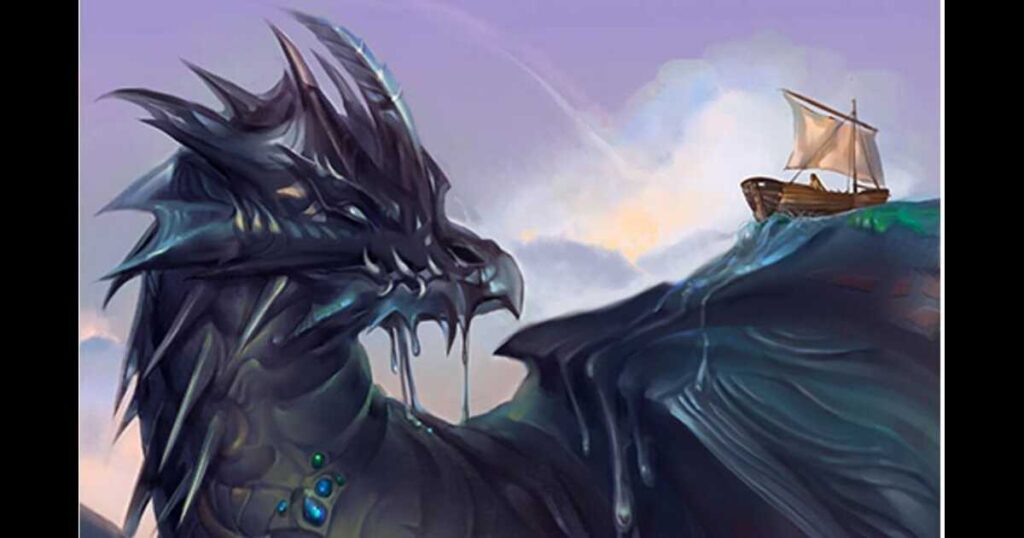
Meet Tiamat, the mother of all dragons and the queen of chaos in ancient Mesopotamian myths. Imagine a massive sea serpent who gave birth to the first gods, that’s Tiamat for you.
She’s not your typical evil goddess, but rather a primal force of nature that represents the wild, untamed parts of the world.
In the famous Babylonian creation story, Tiamat gets into a huge fight with the younger gods. It’s like a cosmic family feud that ends with the god Marduk splitting Tiamat in half to create the heavens and earth.
This tale shows how the ancient Mesopotamians saw the world as a constant battle between order and chaos.
While some might call Tiamat an evil goddess, it’s not that simple. In Mesopotamian thought, she represented the raw power of nature – scary and destructive, sure, but also the source of all life.
It’s like how we might fear the ocean’s power but also rely on it for food and travel. Tiamat reminds us that in ancient myths, gods and goddesses were often as complex and unpredictable as nature itself.
Tiamat’s Legacy in Modern Culture
While Tiamat may have been defeated in Babylonian myth, her influence lives on in modern popular culture. From fantasy literature to role-playing games, the image of Tiamat as a powerful dragon goddess continues to captivate imaginations.
Her story serves as a reminder of the eternal struggle between order and chaos, and the complex relationship between creation and destruction.
| Criteria | Description |
| Name | Tiamat |
| Domain | Primordial goddess of the ocean, chaos, and creation |
| Origin | One of the earliest beings in Mesopotamian mythology, linked with the creation of the world |
| Symbols | Serpent or dragon, saltwater ocean, chaos, and primal forces |
| Attributes | Chaos, primal power, creation, destruction, and motherhood |
Lilith: The Demonized Figure in Various Cultures
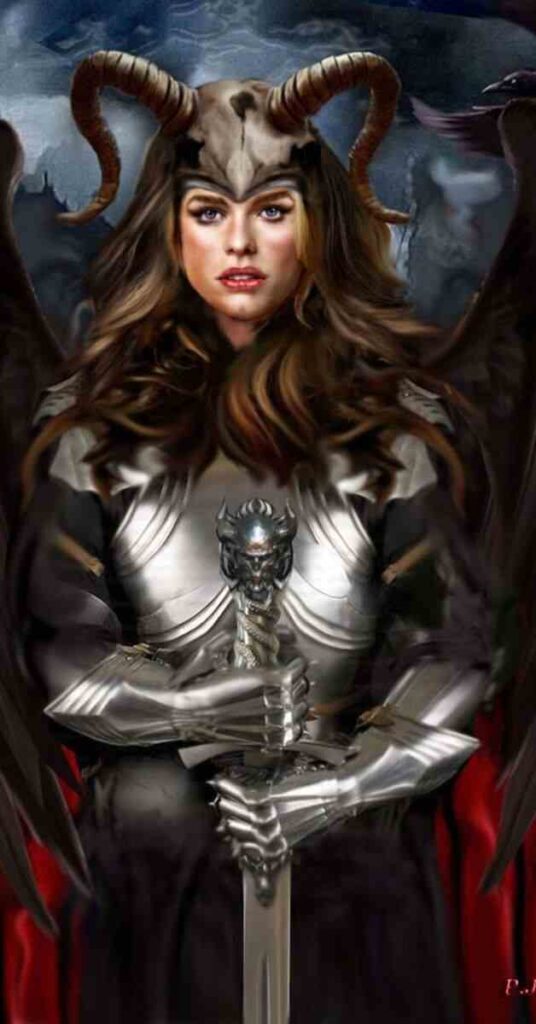
Lilith, a figure often associated with rebellion and independence, appears in various cultures as one of the evil goddess names. In Jewish folklore, she’s portrayed as Adam’s first wife who refused to submit to him, leading to her exile from Eden.
This act of defiance against patriarchal norms has made Lilith a symbol of feminine power for some, while others view her as one of the evil deities.
Many ancient myths show Lilith as a night demon, child-stealer, or seductress, aligning her with other malevolent female entities in different mythologies.
Her reputation as a dangerous and alluring figure has persisted throughout history, influencing art, literature, and popular culture.
Despite her negative portrayal, some modern interpretations see Lilith’s story as a tale of strength and refusal to conform.
The concept of Lilith has evolved, with some viewing her as a misunderstood character rather than inherently evil.
In some feminist interpretations, she represents the struggle for equality and the consequences of challenging established power structures.
Whether seen as a demon or a symbol of empowerment, Lilith remains a complex and intriguing figure in the pantheon of mythological beings.
Lilith in Modern Interpretations
In contemporary culture, Lilith has become a complex symbol of female empowerment and the dark feminine. She appears in literature, art, and even astrology, where “Black Moon Lilith” represents a point in space associated with one’s deepest, most primal desires.
This modern Lilith realizes destructive and creative aspects of feminine power, challenging us to confront our shadows.
Bastet: The Egyptian Goddess
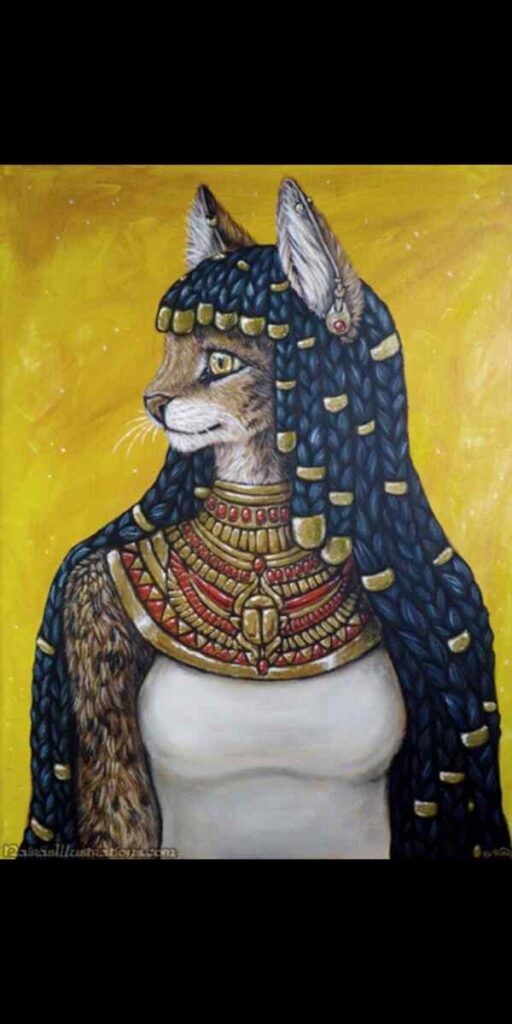
Bastet is the ancient Egyptian goddess who was originally depicted as a fierce lioness before evolving into a cat-headed creator. Bastet was generally seen as a protector and bringer of good fortune.
She stood out among Egyptian deities for her dual nature as a nurturing figure and a fearsome warrior.
While not typically counted among evil deities, Bastet could be vengeful when angered, showcasing the complex nature of Egyptian gods.
Her role as a guardian of the pharaoh and defender against evil spirits made her a popular goddess among royalty and common people.
Bastet’s worship spread throughout Egypt, with her main cult center in the city of Bubastis.
The goddess Bastet’s transformation from a lion to a cat reflected changing attitudes in Egyptian society. Cats became revered for their ability to control vermin and protect crops.
Bastet’s image softened. Her festivals were known for their joyous celebrations, contrasting with the somber rituals of some other Egyptian deities, including those sometimes viewed as evil goddesses in other cultures.
Bastet’s Festivals and Worship
The worship of Bastet was widespread in ancient Egypt, with her main cult center being the city of Bubastis in the Nile Delta. Herodotus described grand festivals held in her honor.
Where thousands of believers would gather to celebrate with music, dance, and copious amounts of wine. These joyous celebrations contrast with the shady rites associated with many other evil goddess names, highlighting the complexity of Bastet’s character.
Durga: The Warrior Goddess of Hinduism
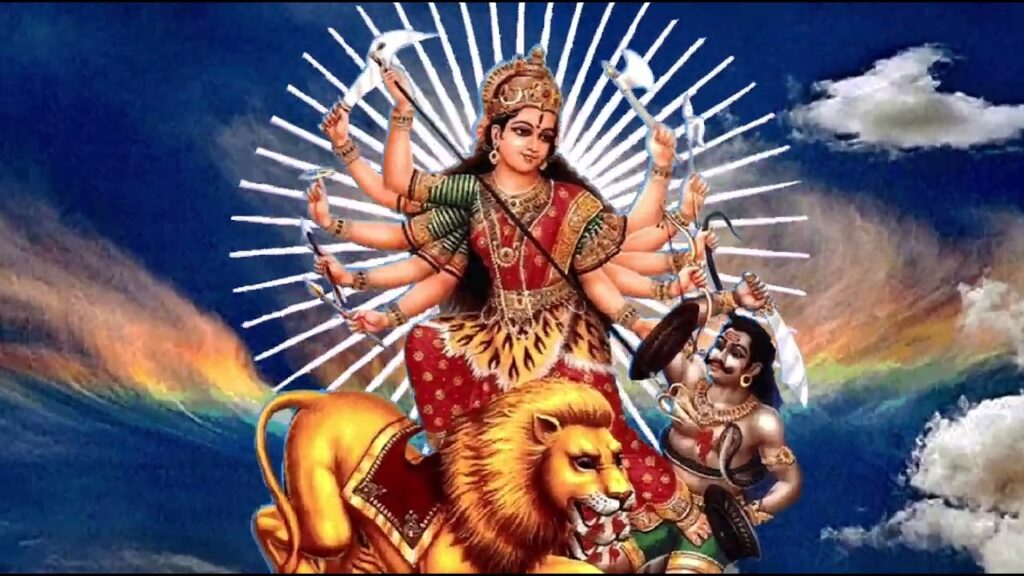
In Hindu mythology, Durga is a standout figure known for her strength and many qualities. Often called “The Invincible One,” Durga represents powerful feminine energy that is both fierce and protective.
Although she isn’t usually seen as an evil goddess, her role as a warrior and her connection with destruction can sometimes lead to misunderstandings, especially in Western views of Hinduism.
Durga is frequently shown riding a tiger or lion and holding various weapons in her many arms. This imagery highlights her role as a guardian of order, ready to fight any threat to righteousness.
One of her most famous stories involves her being created by the gods to defeat the buffalo demon Mahishasura, who was too powerful for male gods to conquer. This tale emphasizes Durga’s role as a defender of good, showing that powerful female deities don’t have to be viewed as evil.
Durga Puja: Celebrating the Divine Mother
One of the most significant festivals in Hinduism, Durga Puja, celebrates the victory of Durga over evil. This annual event, particularly popular in Bengal, involves elaborate rituals, art installations, and community gatherings.
The festival honors Durga’s martial prowess and also celebrates her as a mother figure, highlighting the nurturing aspect of her divine power. This duality of fierce protector and loving mother exemplifies the complex nature of many evil deities in world mythologies.
Ishtar: Mesopotamian Queen of Heaven
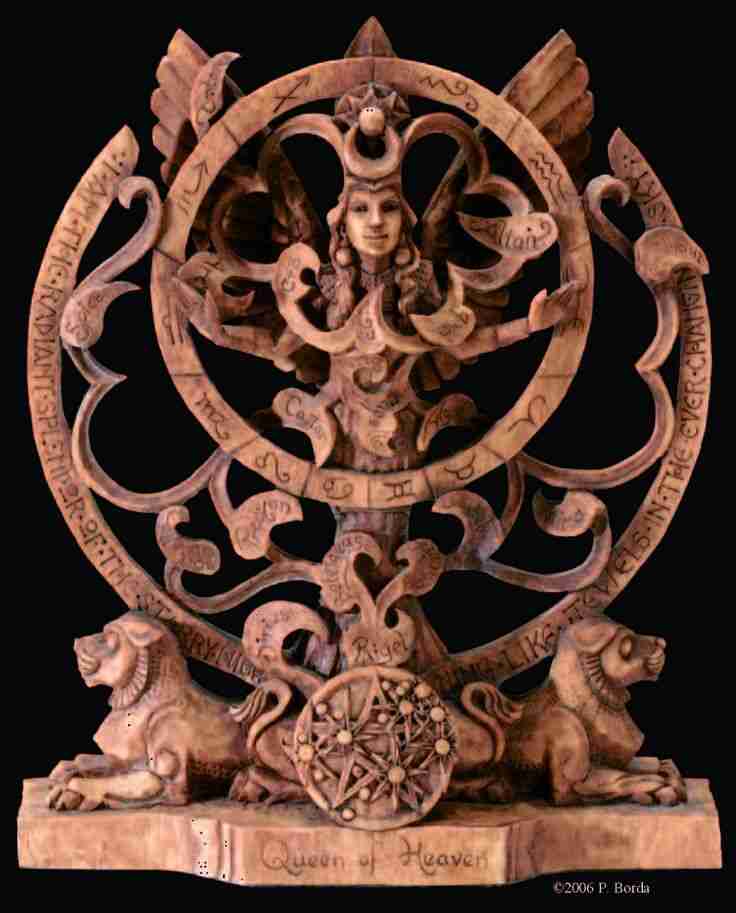
Our journey through evil goddess names brings us back to ancient Mesopotamia, where we encounter Ishtar, the Queen of Heaven and Earth.
Associated with love, beauty, sex, war, justice, and political power, Ishtar is a complex deity who embodies both creative and destructive forces.
Her dual nature as a goddess of love and war has sometimes led to her classification among evil goddesses, this is a simplification of her rich mythological role.
Ishtar’s most famous myth tells of her descent into the underworld, a journey that causes all earthly fertility to cease. This story is one of the oldest recorded myths in human history.
That showcases Ishtar’s power over life and death, and willingness to face the darkest realms for her purposes.
Her aggressive activity of lovers, including the hero Gilgamesh who spurns her advances, has sometimes been interpreted as a destructive or evil trait.
These stories can also be seen as expressions of female agency and power in a largely patriarchal society.
Ishtar’s Influence on Later Mythologies
Ishtar’s impact went beyond Mesopotamia, influencing later goddesses like the Greek Aphrodite and the Roman Venus. Known for her dual nature as a goddess of love and war, creation and destruction.
Ishtar captivates scholars and spiritual seekers. Her story shows us that what we might label evil is often just a powerful force that people find hard to understand or control.
Read Also: 70 Fun Facts About Soccer
Frequently Asked Questions
Who is Kali?
Kali is a Hindu goddess of destruction, time, and death, known for her fierce and protective nature.
What is Hecate known for?
Hecate is a Greek goddess of magic, witchcraft, and the night, often seen as a guide at a crossroads.
What does Morrigan represent?
The Morrigan is a Celtic goddess of war, fate, and sovereignty, often depicted as a trio of war goddesses.
What is Tiamat’s role in mythology?
Tiamat is a Mesopotamian goddess of the ocean and chaos, known for her creation and destruction powers.
How did Ishtar influence other mythologies?
Ishtar’s traits influenced later goddesses like Aphrodite and Venus, blending themes of love and war.
Conclusion
With these eight notorious evil goddesses, we see how different cultures view power and divinity. From Kali’s fierce destruction to Ishtar’s dual nature, these deities challenge our ideas about good and evil. Their stories remind us that what we call “evil” often reflects deeper, more complex forces.
These goddesses, with rich symbols and varied roles, show how mythology mirrors human fears and values. As we continue to study and reinterpret these ancient figures, we gain insight into past cultures and our understanding of power and divinity.
